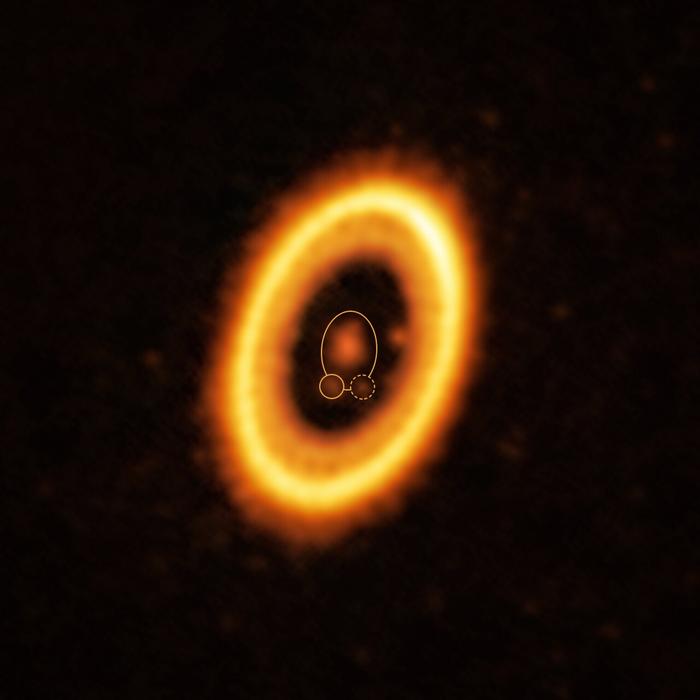Astronomers have spotted the first solid evidence for a planetary Trojan body forming in another system outside our own.

ALMA (ESO / NAOJ / NRAO) / Balsalobre-Ruza et al. / Astronomy & Astrophysics 2023
Can two worlds occupy the same orbit? Theory says yes: There are gravitationally stable regions leading and trailing a planet in its orbit, so it's possible a second world, with up to a super-Earth in mass, could form at the same distance from a host star as a much larger gas giant. But we haven’t seen anything quite like that — yet.
In a report to appear in Astronomy & Astrophysics, Olga Balsalobre-Ruza (Center of Astrobiology, Spain) and colleagues report the discovery of emission from a clump of dust in just such a stable region, trailing behind the already-discovered newborn planet PDS 70b.
“I was not expecting that we could detect Trojan bodies,” says exoplanet expert Sebastiaan Haffert (University of Arizona), who was not involved in the current study. “The authors of this work make a very compelling case.”
About 370 light-years away from Earth, and 20 astronomical units (a.u.) from its 5 million-year-old host star, the gas giant planet PDS 70b is still in its infancy. It’s enshrouded in dust, which glows brightly in images taken by the Atacama Large Millimeter/submillimeter Array (ALMA) in Chile. Applying new processing techniques to publicly available images in the ALMA archive, Balsalobre-Ruza and her team found that a second glob of hot dust appears to be following PDS 70b around its star.
That clump’s glow indicates that it holds up to two Moons worth of mass in dust grains, but there may be more than that, Balsalobre-Ruza points out. “The ALMA data we have used for this detection is only sensitive to dust particles with sizes of 2 millimeters,” she explains. “This means that more particles of different sizes are expected to be in the region.”
This clump of dust has the potential to form a planet, she notes, or it might even enshroud an already-formed world. However, Haffert adds that, since there’s so little dust mass in the region, we might be seeing the formation of a smaller body, like the largest asteroids in the main belt of the solar system. In fact, Balsalobre-Ruza prefers not to even give a name to the emission until more is known about its nature. Future observations at infrared wavelengths could detect emission directly from the forming object(s), rather than the surrounding dust, to settle the issue.
The best opportunity to confirm that the emission actually shares PDS 70b’s orbit could come as early as February 2026. That’s when the dusty masses should have gone far enough around the star to confirm their co-orbital motion.
“The PDS 70 system is really a unique system that allows us to test planet formation theories,” Haffert says. “It is really cool that we learn so much from this system alone.”
 4
4









Comments
Yaron Sheffer
July 20, 2023 at 7:24 am
Strange orbit, not aligned with the rest of the system. My money is on the option that the orbit *is* aligned, thus avoiding the co-orbitality. The new smudge, PDS 70d if you will, could have its own orbital path between 70b and 70c. Then again, I have very little money to begin with…
You must be logged in to post a comment.
jrmorgan07
July 25, 2023 at 11:58 am
There is at least 8+ very-faint features shown in the image, which are outside of the main dust ring or on its outer rim. Are these proto-planets, background galaxies or artifacts from the image?
You must be logged in to post a comment.
Richard-Taylor
July 28, 2023 at 2:28 pm
If a planet can share its orbit with a substantial other body, does that mean we have to revise our definition of "planet"? At the moment, to be a planet, a body must clear its orbit of other objects.
You must be logged in to post a comment.
Monica YoungPost Author
July 28, 2023 at 2:37 pm
The point in IAU's planet definition about planets clearing the neighborhood around their orbit refers to a planet's ability to dominate the dynamics of its orbit. Trojans exist in the solar system, too, such as the plentiful Trojan asteroids around Jupiter — but the key point is that their orbits are ultimately determined by Jupiter's gravity. That is, it's Jupiter's gravity that makes the L4 and L5 Lagrange points gravitationally stable regions to begin with.
Put another way, things are flying around the solar system all the time, because it's easy for gravitational perturbations to nudge a small body onto a different orbit. So it's not that there are no small bodies in Jupiter's orbit, but that those bodies will have their behavior dominated by Jupiter's. Either they'll eventually settle into a gravitationally stable region, or they'll eventually collide with or otherwise be gravitationally scattered by Jupiter itself.
(Also, technically speaking, IAU's definition of planet only applies to objects in the solar system. There is no "official" definition of an extrasolar planet.)
You must be logged in to post a comment.
You must be logged in to post a comment.